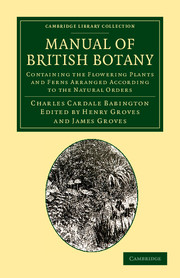42 results
Contributors
-
-
- Book:
- Settlement, Society and Cognition in Human Evolution
- Published online:
- 05 February 2015
- Print publication:
- 26 January 2015, pp xiii-xvi
-
- Chapter
- Export citation
Division 3 - COROLLIFLORÆ. Pet. united, at least at the base. Stam. mostly epipetalous
-
- Book:
- Manual of British Botany
- Published online:
- 05 March 2014
- Print publication:
- 21 February 2013, pp 182-349
-
- Chapter
- Export citation
Division II - FLORIDÆ
-
- Book:
- Manual of British Botany
- Published online:
- 05 March 2014
- Print publication:
- 21 February 2013, pp 393-445
-
- Chapter
- Export citation

Manual of British Botany
- Containing the Flowering Plants and Ferns Arranged According to the Natural Orders
-
- Published online:
- 05 March 2014
- Print publication:
- 21 February 2013
ERRATA
-
- Book:
- Manual of British Botany
- Published online:
- 05 March 2014
- Print publication:
- 21 February 2013, pp xii-xii
-
- Chapter
- Export citation
INDEX TO THE POPULAR ENGLISH NAMES
-
- Book:
- Manual of British Botany
- Published online:
- 05 March 2014
- Print publication:
- 21 February 2013, pp 576-580
-
- Chapter
- Export citation
SYNOPSIS OF THE NATURAL ORDERS OF BRITISH PLANTS
-
- Book:
- Manual of British Botany
- Published online:
- 05 March 2014
- Print publication:
- 21 February 2013, pp xxx-xxxviii
-
- Chapter
- Export citation
CLASS II. MONOCOTYLEDONES
-
- Book:
- Manual of British Botany
- Published online:
- 05 March 2014
- Print publication:
- 21 February 2013, pp -
-
- Chapter
- Export citation
A GLOSSARY OF THE TERMS USED IN THE MANUAL
-
- Book:
- Manual of British Botany
- Published online:
- 05 March 2014
- Print publication:
- 21 February 2013, pp xiii-xxix
-
- Chapter
- Export citation
PREFACE
-
- Book:
- Manual of British Botany
- Published online:
- 05 March 2014
- Print publication:
- 21 February 2013, pp iii-viii
-
- Chapter
- Export citation
Division 1 - THALAMIFLORÆ. Pet. distinct (rarely 0) and as well as the stam. growing separately from the sepals, hypogynous
-
- Book:
- Manual of British Botany
- Published online:
- 05 March 2014
- Print publication:
- 21 February 2013, pp 1-82
-
- Chapter
- Export citation
APPENDIX
-
- Book:
- Manual of British Botany
- Published online:
- 05 March 2014
- Print publication:
- 21 February 2013, pp 545-568
-
- Chapter
- Export citation
PREFACE TO THE NINTH EDITION
-
- Book:
- Manual of British Botany
- Published online:
- 05 March 2014
- Print publication:
- 21 February 2013, pp ix-xi
-
- Chapter
- Export citation
Division III - GLUMIFERÆ
-
- Book:
- Manual of British Botany
- Published online:
- 05 March 2014
- Print publication:
- 21 February 2013, pp 446-514
-
- Chapter
- Export citation
ABBREVIATIONS
-
- Book:
- Manual of British Botany
- Published online:
- 05 March 2014
- Print publication:
- 21 February 2013, pp lii-lii
-
- Chapter
- Export citation
CLASS I. DICOTYLEDONES
-
- Book:
- Manual of British Botany
- Published online:
- 05 March 2014
- Print publication:
- 21 February 2013, pp -
-
- Chapter
- Export citation
Division 4 - MONOCHLAMYDEÆ. Only a single perianth or none
-
- Book:
- Manual of British Botany
- Published online:
- 05 March 2014
- Print publication:
- 21 February 2013, pp 349-390
-
- Chapter
- Export citation
Division 2 - CALYCIFLORÆ. Pet. distinct and, as well as the stam., perigynous or epigynous
-
- Book:
- Manual of British Botany
- Published online:
- 05 March 2014
- Print publication:
- 21 February 2013, pp 82-181
-
- Chapter
- Export citation
Frontmatter
-
- Book:
- Manual of British Botany
- Published online:
- 05 March 2014
- Print publication:
- 21 February 2013, pp i-ii
-
- Chapter
- Export citation
Class III. CRYPTOGAMEÆ
-
- Book:
- Manual of British Botany
- Published online:
- 05 March 2014
- Print publication:
- 21 February 2013, pp 515-544
-
- Chapter
- Export citation

